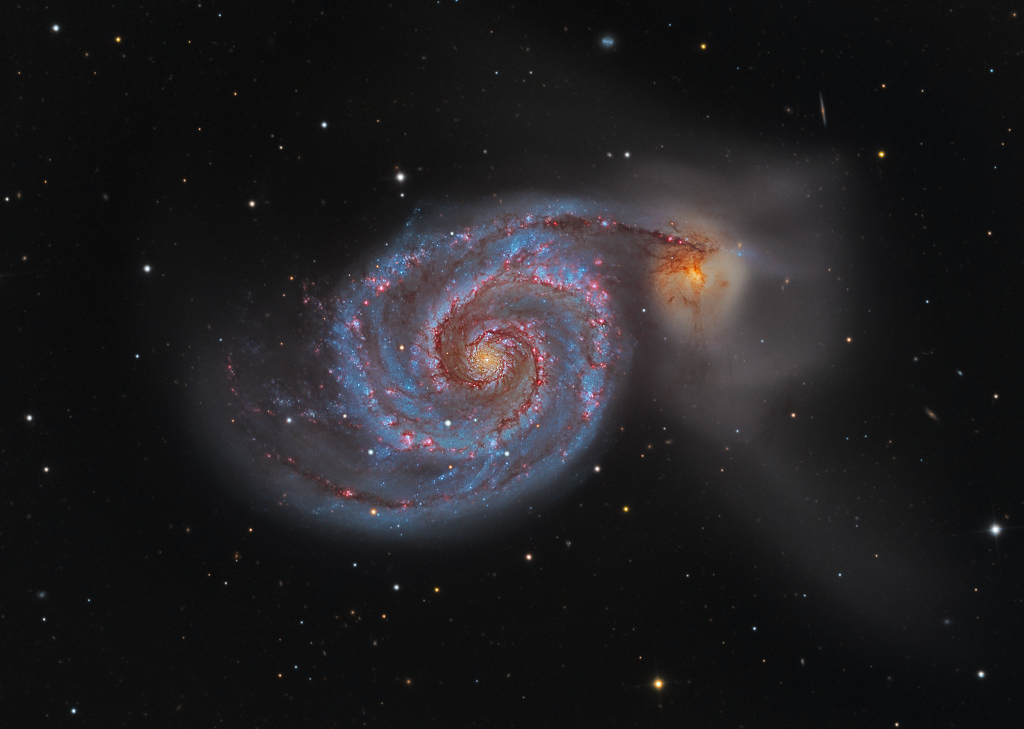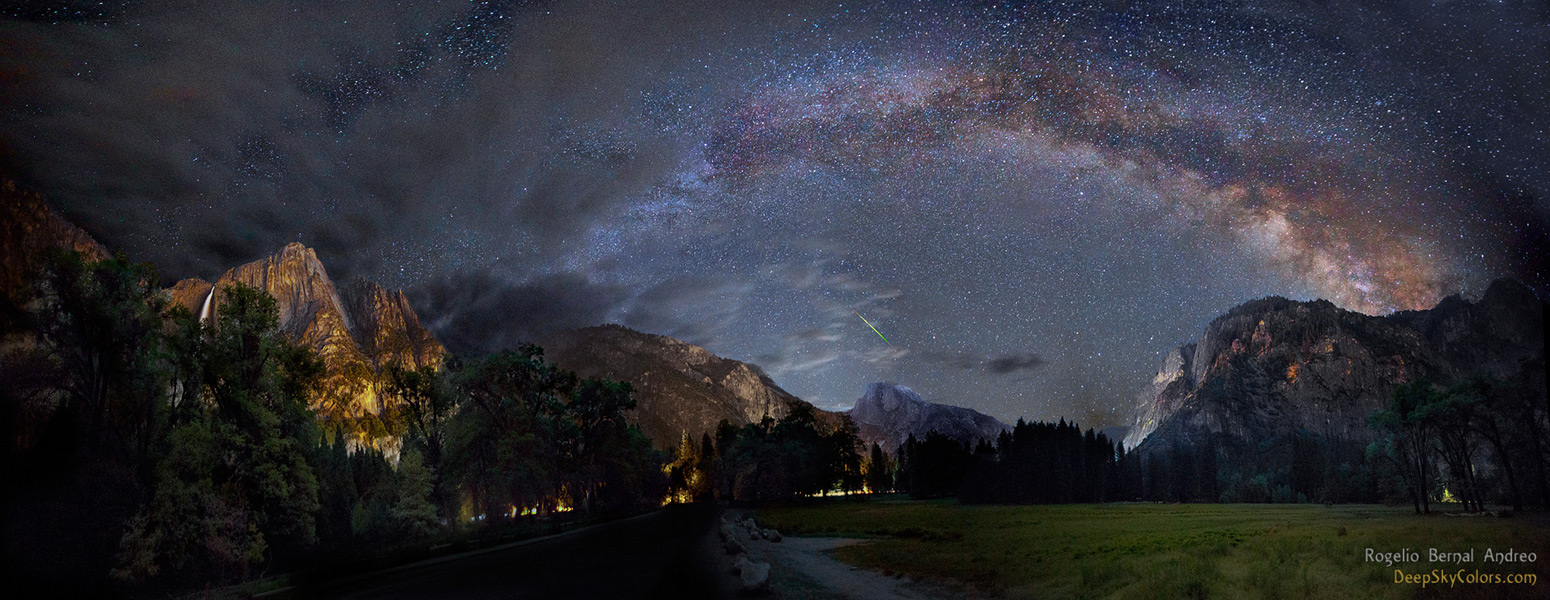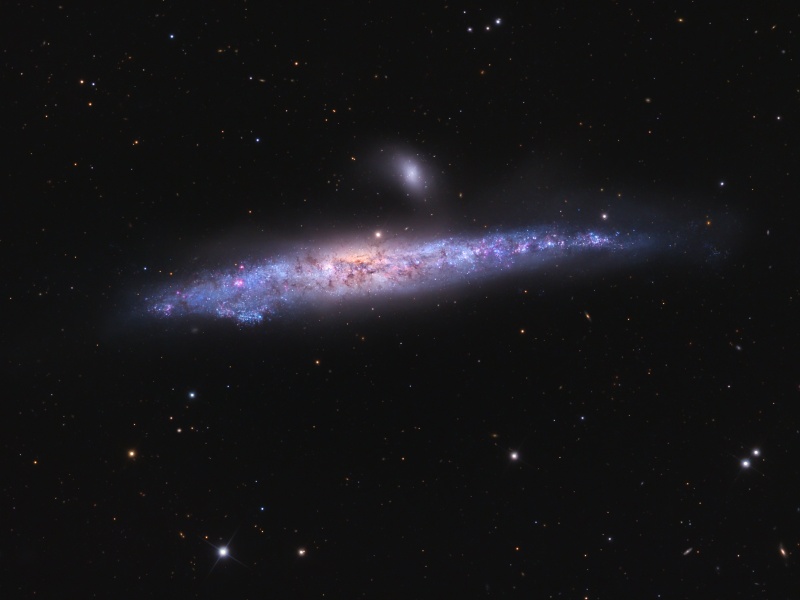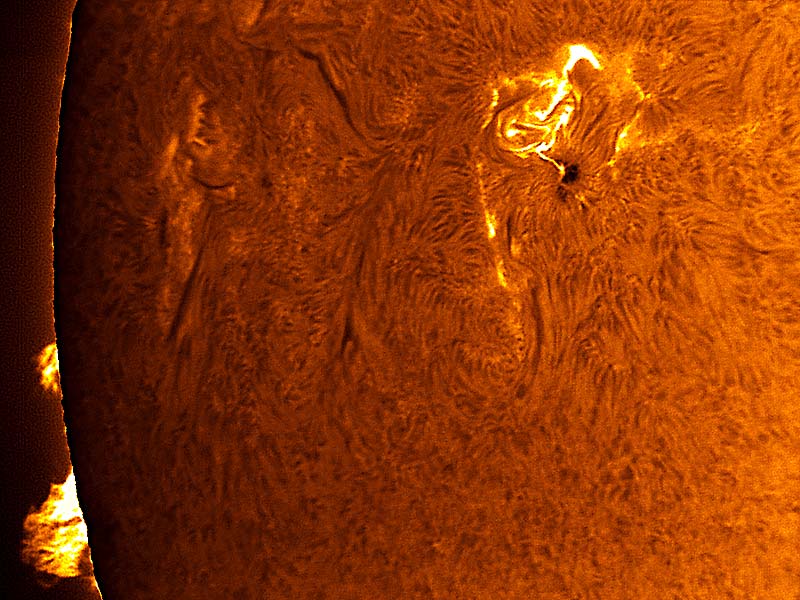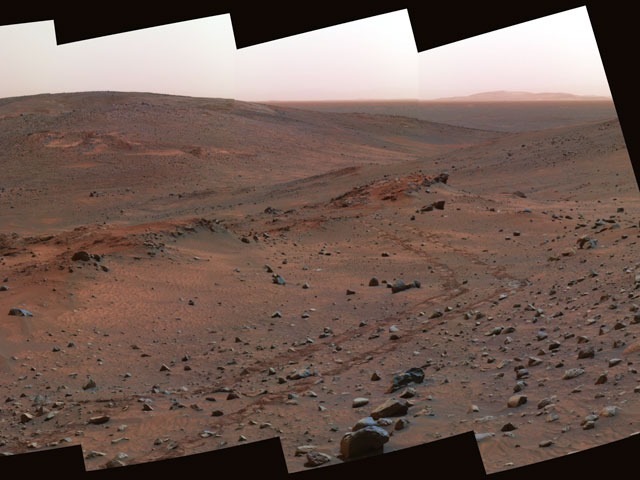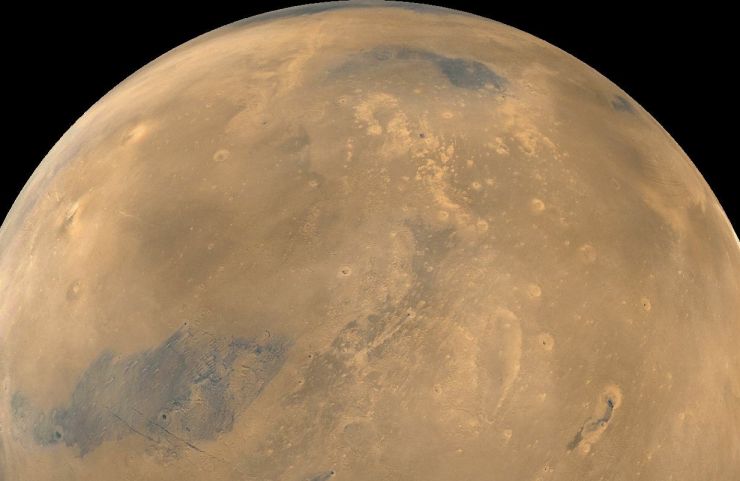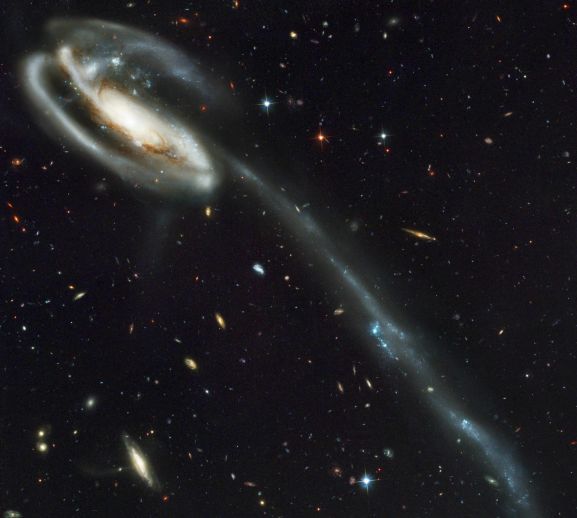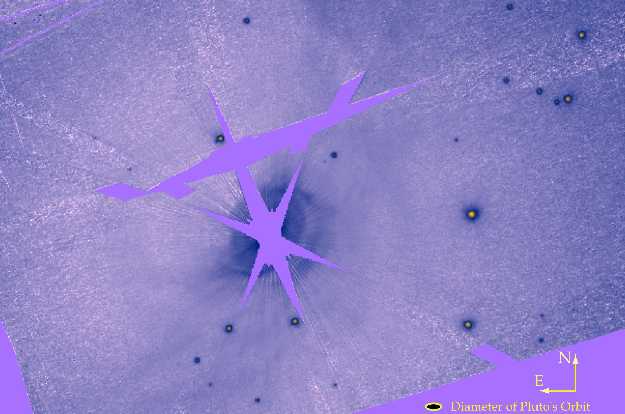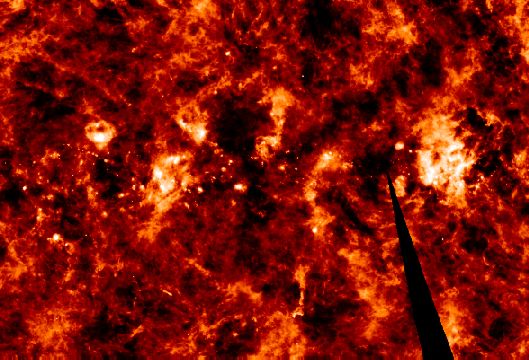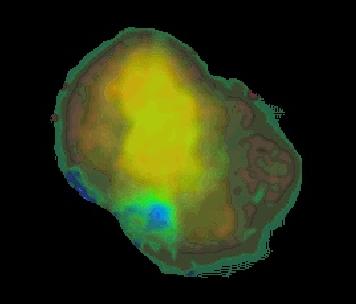| << Previous | Index | Next >> |
2015 Follow the handle of the Big Dipper away from the dipper's bowl until you get to the handle's last bright star. Then, just slide your telescope a little south and west and you might find this stunning pair of interacting galaxies, the 51st entry in Charles Messier famous catalog. Perhaps the original spiral nebula, the large galaxy with well defined spiral structure is also cataloged as NGC 5194. Its spiral arms and dust lanes clearly sweep in front of its companion galaxy (right), NGC 5195. The pair are about 31 million light-years distant and officially lie within the angular boundaries of the small constellation Canes Venatici. Though M51 looks faint and fuzzy to the eye, deep images like this one can reveal striking colors and the faint tidal debris around the smaller galaxy.
2014 Captured one night last May this eight frame mosaic starts on the left, down Northside Drive through Yosemite National Park. It ends thousands of light-years away though, as the arc of the Milky Way tracks toward the center of our galaxy on the right, far beyond the park's rugged skyline. That night was still moonless when the storm clouds retreated, so the rocky faces of the surrounding mountains are lit by campfires and artifical lights. Yosemite Falls is at the left. The granite face of Half Dome juts above the far horizon, near the center of the view. The remarkable flash above it is a bright meteor. Part of the annual Eta Aquarid meteor shower the colorful streak is moving up, its trail pointing directly back to the shower's radiant, low in Aquarius. This year's Eta Aquarids should peak in the moonless early morning hours of May 6 as the Earth sweeps through dust from the tail of Comet Halley.
2013 Acquiring its first sunlit views of far northern Saturn late last year, the Cassini spacecraft's narrow-angle camera recorded this stunning image of the vortex at the ringed planet's north pole. The false color, near-infrared image results in red hues for low clouds and green for high ones, causing the north-polar hurricane to take on the appearance of a rose. Enormous by terrestrial hurricane standards, this storm's eye is about 2,000 kilometers wide, with clouds at the outer edge traveling at over 500 kilometers per hour. The north pole Saturn hurricane swirls inside the large, six-sided weather pattern known as the hexagon. Of course, in 2006 Cassini also imaged the hurricane at Saturn's south pole.
2012 Although its colors may be subtle, Saturn's moon Helene is an enigma in any light. The moon was imaged in unprecedented detail last June as the robotic Cassini spacecraft orbiting Saturn swooped to within a single Earth diameter of the diminutive moon. Although conventional craters and hills appear, the above image also shows terrain that appears unusually smooth and streaked. Planetary astronomers are inspecting these detailed images of Helene to glean clues about the origin and evolution of the 30-km across floating iceberg. Helene is also unusual because it circles Saturn just ahead of the large moon Dione, making it one of only four known Saturnian moons to occupy a gravitational well known as a stable Lagrange point.
2011 It is a hurricane twice the size of the Earth. It has been raging at least as long as telescopes could see it, and shows no signs of slowing. It is Jupiter's Great Red Spot, the largest swirling storm system in the Solar System. Like most astronomical phenomena, the Great Red Spot was neither predicted nor immediately understood after its discovery. Still today, details of how and why the Great Red Spot changes its shape, size, and color remain mysterious. A better understanding of the weather on Jupiter may help contribute to the better understanding of weather here on Earth. The above image is a recently completed digital enhancement of an image of Jupiter taken in 1979 by the Voyager 1 spacecraft as it zoomed by the Solar System's largest planet. At about 117 AU from Earth, Voyager 1 is currently the most distant human made object in the universe and expected to leave the entire solar heliosheath any time now.
2010 Almost every object in the above photograph is a galaxy. The Coma Cluster of Galaxies pictured above is one of the densest clusters known - it contains thousands of galaxies. Each of these galaxies houses billions of stars - just as our own Milky Way Galaxy does. Although nearby when compared to most other clusters, light from the Coma Cluster still takes hundreds of millions of years to reach us. In fact, the Coma Cluster is so big it takes light millions of years just to go from one side to the other! Most galaxies in Coma and other clusters are ellipticals, while most galaxies outside of clusters are spirals. The nature of Coma's X-ray emission is still being investigated.
2009
2008 Dark shapes with bright edges winging their way through dusty NGC 6188 are tens of light-years long. The emission nebula is found near the edge of an otherwise dark large molecular cloud in the southern constellation Ara, about 4,000 light-years away. Formed in that region only a few million years ago, the massive young stars of the embedded Ara OB1 association sculpt the fantastic shapes and power the nebular glow with stellar winds and intense ultraviolet radiation. The recent star formation itself was likely triggered by winds and supernova explosions, from previous generations of massive stars, that swept up and compressed the molecular gas. A false-color Hubble palette was used to create the this gorgeous wide-field image and shows emission from sulfur, hydrogen, and oxygen atoms in red, green, and blue hues. At the estimated distance of NGC 6188, the picture spans about 300 light-years.
2007 How might a sunrise appear on Gliese 581c? One artistic guess is shown above. Gliese 581c is the most Earth-like planet yet discovered and lies a mere 20 light-years distant. The central red dwarf is small and redder than our Sun but one of the orbiting planets has recently been discovered to be in the habitable zone where liquid water could exist on its surface. Although this planet is much different from Earth, orbiting much closer than Mercury and containing five times the mass of Earth, it is now a candidate to hold not only oceans but life enabled by the oceans. Were future observations to confirm liquid water, Gliese 581c might become a worthy destination or way station for future interstellar travelers from Earth. Drawn above in the hypothetical, the red dwarf star Gliese 581 rises through clouds above a calm ocean of its planet Gliese 581c.
2006 An unusually active sunspot region is now crossing the Sun. The region, numbered 875, is larger than the Earth and has produced several solar flares over the past week. It should take a few more days for Sunspot 875 to finish crossing the solar disk. The above image of the Sun was taken last Wednesday in a very specific color of red light to bring up detail. Sunspot 875, in the midst of erupting a large Class C solar flare, can be seen as the dark region to the upper right. In the above image, relatively cool regions appear dark while hot regions appear bright. On the far left, solar prominences are visible hovering above the Sun's surface.
2005 What is the history of the outcropping of rock called Methuselah? The unusual rock group is visible on the left of the above image taken by the robot Spirit rover current exploring Mars. Methuselah was discovered while maneuvering over hilly terrain and shows unusual multiple layering that caught the attention of the rover science team. Since the above representative color image was taken about three weeks ago, Spirit has moved in to get a closer look. Also visible in the above image are another rock outcrop dubbed Larry's Lookout on the upper right and a larger Clark Hill in the left background. On the far right is a more distant peak of the Columbia Hills.
2004 The strangest moon in the Solar System is bright yellow. This picture, showing Io's true colors, was taken in 1999 July by the Galileo spacecraft that orbited Jupiter from 1995 to 2003. Io's colors derive from sulfur and molten silicate rock. The unusual surface of Io is kept very young by its system of active volcanoes. The intense tidal gravity of Jupiter stretches Io and damps wobbles caused by Jupiter's other Galilean moons. The resulting friction greatly heats Io's interior, causing molten rock to explode through the surface. Io's volcanoes are so active that they are effectively turning the whole moon inside out. Some of Io's volcanic lava is so hot it glows in the dark.
2003 Come December 2003 - January 2004, an armada of five new invaders from Earth should arrive on the shores of the Red Planet -- the Japanese ( ISAS) Nozomi orbiter, the European Space Agency's Mars Express orbiter carrying the Beagle 2 lander, and NASA's own two Mars Exploration Rovers. While Nozomi began its interplanetary voyage in 1998, the other spacecraft are scheduled for launch windows beginning this June. Clearly, earthdwellers remain intensely curious about Mars and the tantalizing possibility of past or present martian life, with these robotic missions focussing on investigating the planet's atmosphere and the search for water. This mosaic of over 100 Viking 1 orbiter images of Mars was recorded in 1980 and is projected to show the perspective seen from an approaching spacecraft at a distance of 2,000 kilometers. Exceptional views of Mars will be possible from earthbound telescopes in August and September.
2002 In this stunning vista recorded with the Hubble Space Telescope's new advanced camera, distant galaxies form a dramatic backdrop for disrupted spiral galaxy Arp 188, the Tadpole Galaxy. The cosmic Tadpole is a mere 420 million light-years distant toward the northern constellation Draco. Its eye-catching tail is about 280 thousand light-years long and features massive, bright blue star clusters. One story goes that a more compact intruder galaxy crossed in front of Arp 188 - from left to right in this view - and was slung around behind the Tadpole by their gravitational attraction. During the close encounter, tidal forces drew out the spiral galaxy's stars, gas, and dust forming the spectacular tail. The intruder galaxy itself, estimated to lie about 300 thousand light-years behind the Tadpole, can be seen through foreground spiral arms at the upper left. Following its terrestrial namesake, the Tadpole Galaxy will likely lose its tail as it grows older, the tail's star clusters forming smaller satellites of the large spiral galaxy.
2001 More than 100 billion boulders may be swarming in the disk around nearby star HD 100546. In a scene thought similar to the early years of our own Solar System, ever larger rocks are growing by colliding and accreting dust as the messy business of planet formation appears to be underway. For an Earth-like planet in such a hostile environment, the sky would be lit continuously with streaking meteors and the ground would rumble continuously with impacts. Pictured above, the swirling disk of dust, gas, and rocks of HD 100546 is visible as the dark region surrounding the image center. The bright light and six-pointed diffraction spikes from the central star have been removed from the false-color image. HD 100546 is visible with binoculars towards the southern constellation of Musca, and is a relatively nearby 335 light-years away. Similar planet-building systems, dubbed proplyds, have recently been found in Orion, where many emerging planets there must survive the boiling radiations of neighboring bright stars.
2000 Did you see that flash? Lasting only about 15 seconds, it's possible that nobody you ask can confirm it, but what you might have seen is sunlight reflecting off an orbiting Iridium satellite. Satellites of all types have been providing streaks and glints visible only since the launch of Sputnik I in 1957. Of these, flares from any of the 66 Iridium satellites can be particularly bright, sometimes even approaching the brightness of the Moon. If the Iridium satellites are programmed to re-enter the Earth's atmosphere, they might provide even brighter flares as they burn up. Pictured above, the streak from an Iridium satellite punctuates a picturesque sunset in San Sebastian, Spain. Then again, that sky-flash you saw? If it lasted only a second or two, it might have been a meteor.
1999 Newborn stars are forming in the Eagle Nebula. This image, taken with the Hubble Space Telescope in 1995, shows evaporating gaseous globules (EGGs) emerging from pillars of molecular hydrogen gas and dust. The giant pillars are light years in length and are so dense that interior gas contracts gravitationally to form stars. At each pillars' end, the intense radiation of bright young stars causes low density material to boil away, leaving stellar nurseries of dense EGGs exposed. The Eagle Nebula, associated with the open star cluster M16, lies about 7000 light years away.
1998 Astronomers have discovered that looking at dust along the plane of our Milky Way Galaxy is a bit like looking into a frothy glass of beer. The dust between stars in our galaxy appears to be arranged like a foam with bubbles and voids -- churned by shocks and winds generated as stars cycle through their lives. This processed infrared image, based on data from NASA's IRAS satellite, maps the radiation from the edges of galactic dust clouds and reveals the complex distribution. The image covers an area of about 40x60 degrees centered on the galactic plane near the Cygnus region. It shows bright bubble-shaped and arc-like dust clouds around the supernova remnants and starbirth regions embedded in the galactic disk.
1997 The life-cycles of stars help drive the ecology of our Galaxy, churning, processing, and redistributing matter. Massive stars reach a spectacular evolutionary endpoint - supernovae explosions which blast off their outer layers, violently merging stellar material with the gas and dust of the Milky Way. The supernova remnant IC 443 is typical of the aftermath. Seen in this false color X-ray image are the shocked, expanding shells of gas from a star which exploded thousands of years ago. Known to be interacting with galactic molecular clouds, the expanding supernova remnant was also recently discovered to have regions of intense higher energy X-ray emission (coded blue in this map) near the molecular cloud boundaries. This X-ray emission may indicate that electrons are being accelerated within the remnant, gaining in energy as they surf back and forth across the expanding shock wave. If so, IC 443 could also be one source of our Galaxy's puzzling high energy cosmic-rays.
1996 What makes comet tails so colorful? This photograph of Comet Hyakutake was taken the night of April 18th and highlights different components of the tail. The gold and red tail features are dust, made predominately of little bits of rock and carbon. The dust tail shines by reflecting sunlight. Extending past the dust tail is the comet's ion tail, shown here glowing in blue. The ion tail is composed mostly of ions of water, carbon monoxide, and cyanogen. The ion tail glows by emitting light when elections re-combine with electrically charged ions to make uncharged molecules. The photograph was taken just north of Kansas City, Missouri, USA.
| << Previous | Index | Next >> |
